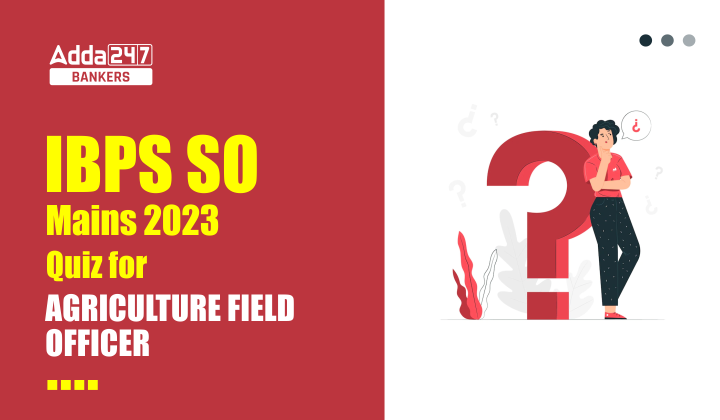Q1. The time period to constitute a panchayat election should be completed before:
(a) 6 months from the date of its dissolution
(b) 8 months from the date of its dissolution
(c) 2 months from the date of its dissolution
(d) 3 months from the date of its dissolution
(e) 5 months from the date of its dissolution
Q2. Which committee was responsible for establishing democratic decentralization which finally known as Panchayati Raj system in India?
(a) Balwant Rai Mehta Committee
(b) Ajit Kumar Committee
(c) Abid Hussain Committee
(d) Basel Committee
(e) None of these
Q3. ________ is the branch of agriculture which deals with business end of farming.
(a) Horticulture
(b) Agronomy
(c) Pomology
(d) Agricultural Economics
(e) Farm management
Q4. Which among the following term is related to chemigation and being used for injecting fertilizers, improving soil quality and other water-soluble products in irrigation system?
(a) Fertigation
(b) Irrigation
(c) Verbalization
(d) Waterlogging
(e) Hydroponics
Q5. In which type of farming, more labour is used for cultivating small plot of land using simple tools by farmers?
(a) Intensive subsistence farming
(b) Extensive agriculture
(c) Shifting agriculture
(d) Nomadic herding
(e) None of these
Q6. In how many states was the ‘Climate Resilience Building among Farmers through Crop Residue Management’ project launched in its first phase?
(a) 3
(b) 4
(c) 2
(d) 7
(e) 10
Q7. There are various factors for soil erosion, biological being one of the factors which is further subdivided into three groups. Which one of the following is also known as erodibility factor?
(a) Energy Factors
(b) Protection Factors
(c) Climatic factor
(d) Resistance Factors
(e) All of these
Q8. The funding pattern of Prime Minister Krishi Sinchayee Yojana – Watershed Development Component (PMKSY – WDC) between center and state in J&K, Himachal Pradesh and Uttarakhand is:
(a) 90: 10
(b) 70: 30
(c) 80: 20
(d) 60: 40
(e) 20: 40
Q9. Which of the following erosion exceeds normal erosion and becomes destructive due to human activities resulting in changes in natural cover and soil conditions?
(a) Accelerated Erosion
(b) Geological Erosion
(c) Water Erosion
(d) Wind Erosion
(e) Both a and b
Q10. Which among the following is ideal soil type for agricultural uses, which is dark in colour and mealy in hands?
(a) Silt soil
(b) Sandy soil
(c) Clay soil
(d) Loam Soil
(e) Both c and d
Solutions
S1. Ans (a)
Sol. If a Panchayat is dissolved, elections are to be held within six months from the date of dissolution. The term Panchayati Raj in India signifies the system of rural local self-government. It had been established after the advice of the Balwant Rai Mehta committee, which is established by the Govt. of India in 1957. This committee has three-tier panchayat governance such as Gram Panchayat, Panchayat Samiti, and Zila Parishad. As a result of this scheme the first Panchayat system introduced in Rajasthan in 1959. This system observed a lack of people’s participation. To overcome this failure a new committee named Ashok Mehta committee gives a two-tier governance plan in 1977. The two-tier plan was Zila Parishad and Mandal Panchayat.
S2. Ans (a)
Sol. The Balwant Rai Mehta Committee was a committee originally appointed by the Government of India on 16 January 1957 to examine the working of the Community Development Programme (2 October 1952) and the National Extension Service (2nd October 1953) and to suggest measures for their better working. The Chairman of this committee was Balwantrai G Mehta. The committee submitted its report on 24 November 1957 and recommended the establishment of the scheme of ‘democratic decentralisation’ which finally came to be known as Panchayati Raj. The main aim of Panchayat raj system is to settle the local problems locally and to make the people politically conscious.
S3. Ans (d)
Sol. There are five specialized branches of agriculture which includes Agricultural economics as one of them. Agricultural economics deals with the application of theory of economics in increasing productivity and distribution of food and other agricultural products. Both micro and macroeconomics are used to solve problems arising in a specific agricultural area. It is a study of crops and type of soil required to grow crops. Agricultural economics influences food policy, agricultural policy, and environmental policy.
S4. Ans (a)
Sol. Fertigation is the term used for injecting fertilizers, improving soil quality and other water-soluble products in the irrigation system. It is related to chemigation which deals with the injection of chemicals into an irrigation system. The process of fertigation is practiced in commercial agriculture.
S5. Ans (a)
Sol. Under intensive subsistence farming, more labour is used for cultivating a small plot of land using simple tools by farmers. It is the type of subsistence farming in which farmers opt for such farming to produce more using limited landholdings. In this farming, farmers produce enough food for survival of their family and remaining produce is exchanged with other goods.
S6. Ans (b)
Sol. The Ministry of Environment, Forest and Climate Change launched a regional project on ‘Climate Resilience Building among Farmers through Crop Residue Management’ under the National Adaptation Fund for Climate Change (NAFCC) on 28 December, 2017.
It aims at tackling the menace of Stubble Burning. Its first phase was approved for the States of Punjab, Haryana, Uttar Pradesh, and Rajasthan at a cost of approximately Rs. 100 Crore.
S7. Ans (d)
Sol. The activities that are related to faulty cultivation practices influence the soil erosion are known as biological factors of soil erosion. There are three groups of biological factors, namely; energy factor, resistance factor and protection factor. Topographical factor is a type of soil erosion factor. Resistance factor enhance the infiltration of water that reduces runoff. This happens due to mechanical and chemical properties of the soil.
S8. Ans (a)
Sol. Prime Minister Krishi Sinchayee Yojana (Watershed Development Component) WDC-PMKSY’s main objective is to harness the ecological balance by harnessing, conserving and developing degraded natural resources. Uniform funding pattern is one of the salient features of WDC-PMKSY which is 60:40 between Centre and state in all the states except North-east and hill states. For hill states (J&K, Himachal Pradesh and Uttarakhand), it is 90:10. For union territories, it is 100% by center.
S9. Ans (a)
Sol. Originally, soil erosion is classified into two types: accelerated and geological erosion. Water erosion, wind erosion and glacial erosion are classified according to erosion agents. Accelerated erosion occurs when human beings come into picture and start depleting soil by their actions like cutting forests, over grazing, ploughing hillsides etc.
S10. Ans (d)
Sol. Loam soil contains balance of all three-soil materials silt, sand and clay plus humus with a proportion of 40-40-20% which can vary with a degree. It also has a higher PH and calcium levels. It retains nutrients and water. It is suitable to grow most of varieties of plants.
ts and water. It is suitable to grow most of varieties of plants.



 GA Capsule for SBI Clerk Mains 2025, Dow...
GA Capsule for SBI Clerk Mains 2025, Dow...
 The Hindu Review October 2022: Download ...
The Hindu Review October 2022: Download ...
 IBPS PO Apply Online 2025, Online Applic...
IBPS PO Apply Online 2025, Online Applic...


